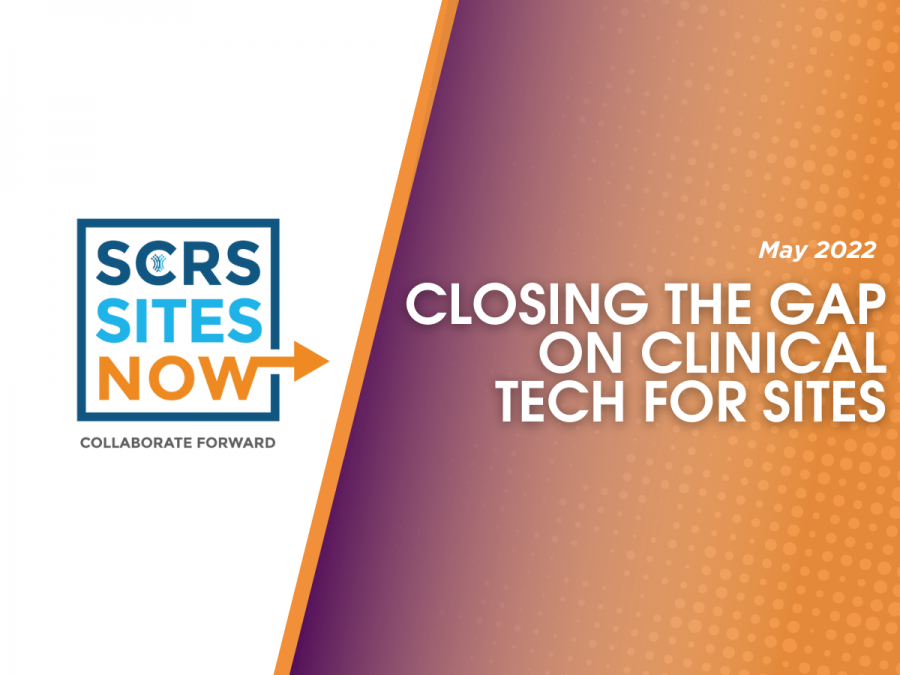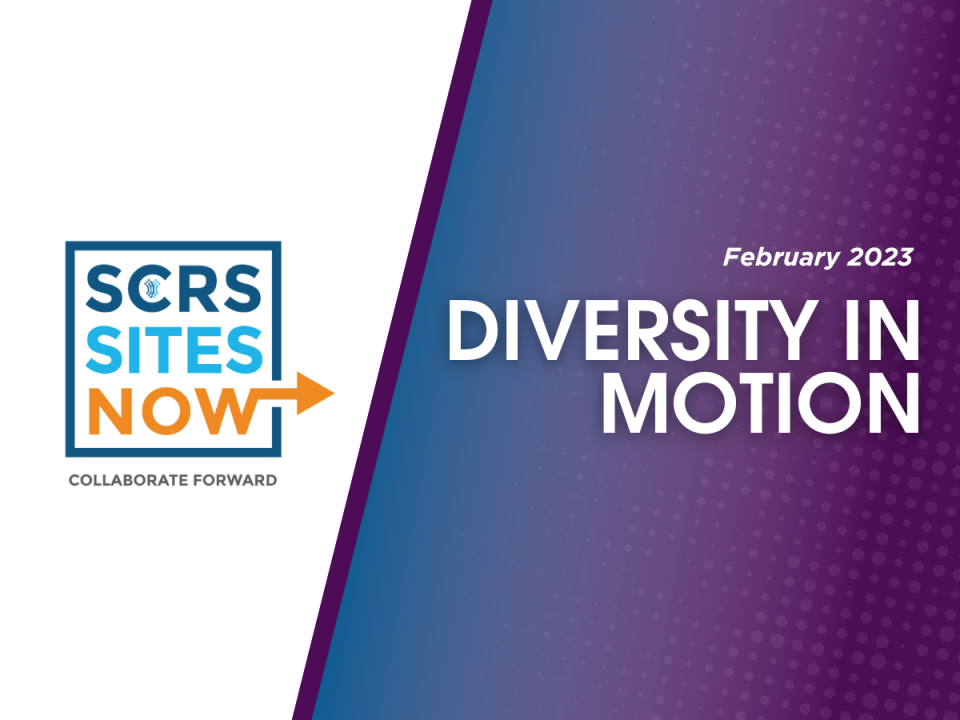Closing the Gap on Clinical Tech for Sites

Clinical tech has been evolving at a rapid pace to solve study-facing challenges. At the 2019 Global Site Solutions Summit, SCRS hosted a Global Impact Partner meeting where we asked, “what is the one priority that our industry needed to heighten awareness and prepare for as we approach 2020?” We left that meeting with an understanding of decentralized clinical trials (DCTs).
“I can’t imagine if we hadn’t prepared for some of that work,” commented Sean Soth, VP of Global Business Partnerships for SCRS. “We worked hard on virtual capabilities, educating the market on what DCTs were. But that’s just one small example of technology that still has many questions.”
While the industry has seen exciting advancements in DCTs and even more technology is being added to the alphabet soup of innovation, sites find themselves in the age-old problem of being asked to do more with less or not enough.
It’s not just investment that matters – it’s the ongoing barriers to training, implementation and user experience that continually impact research site operations and outcomes. Technology innovation often gives way to burden without the insight of practical approaches and understanding of how sites will apply these solutions. The ideas shared in this Sites NOW discussion will explore how we can narrow this gap.
The most important needs in clinical tech right now
Panelist Gary Schwartz said that finding end-to-end solutions that are more platform-based or provide a one-stop shop for sites is a strong trend. This eliminates linkages and interfaces between data modules and applications, as well as the number of site logins required to access various systems. Being able to simplify not only the vendor relationship and management, but the interactions with those technologies, is a critically important need. This will help sites simplify their interactions with a particular trial, as well as the patients participating.
Industry is also looking at how they impact the patient because in the end, that is most important. How do we simplify those interactions? Patient centricity is mentioned frequently across the industry, but awareness is growing that patient-centricity can’t happen without site-centricity. If sites can’t attract patients, then all stakeholders in the industry suffer.
How can site centricity and patient centricity coexist?
With the currently growing shortage of staff, sites want to leverage technology to help them optimize their internal operations so they can focus more on patients. The goal is for technology to help site staff spend more time on higher-value tasks.
However, because all the technology systems may not communicate well or may not perform as well as expected, sites end up spending significantly more time than anticipated using different platforms. “Sites end up actually taking a step back when they were hoping to take a step forward,” said panelist Henry Kravchenko. “That’s a painful thing to see because you should be adopting technology that helps you move forward. If it’s not doing that, it’s a structural issue that needs to be dealt with on multiple levels.”
Panelist Shivani Shah shared a site perspective. What are some of the higher-value tasks that sites are hoping systems will help them solve?
Shah agreed sites need platforms that are end-to-end and simpler for both sites and patients. In the same vein, one of the bigger problems sites are trying to solve is remote and hybrid visits and how technology can support that. Sites need technology that’s easy for them and their patients to use while providing more visibility and oversight for investigators.
Vendors that have a suite of options, versus individual vendors that capture certain data, are becoming more attractive to industry partners as well. “Our challenge right now is that we have a few different softwares that we’re working on in terms of our functional requirements. The next step is how to make sure to have all of this on a consistent platform,” said Shah.
To elaborate on remote and hybrid visit needs, Shah shared that sites are looking for more technology infrastructure around the shipment of labs, making it easier and more convenient for the patient and providing sites with more visibility in ensuring the protocol is followed.
E-consent is also one of the recurring hot topics of discussion for industry. “From the site and patient standpoint, we’re still experiencing growing pains where we have multiple options to work with, but it’s not airtight. We see the benefits of it, but oftentimes we have seen that it increases visit duration, especially for elderly patients,” said Shah.
When and how do sites introduce new solutions to their team and locations? Shah commented that when introducing options for the team, they have a dedicated department that is constantly looking for innovative ideas and strategies. “It usually goes to a pilot phase of introducing it, trying it out with a small team and a smaller site, and then getting all the stakeholders involved with their feedback.” Committees would also be a great option for sites or industry partners that want to share technology ideas and experiences.
Reflecting on how far the industry has come, panelist Mark Ryan shared, “I’ve been doing this a long time – over 25+ years – and was a coordinator before I came to Bayer. I remember some of our biggest concerns back then were where the sealed randomized codes in the envelope were going to be stored at a site. Where do we put that? How did we get signatures on delegation logs on a piece of paper? We had to fax them around to different people to get signatures. Those were big technology challenges back then.”
Today, there are shiny new objects for clinical trials coming out every week. People want to do things differently and try to make life easier, but it’s getting more complicated and even more challenging. “It’s not just challenging for sites – it’s challenging for Sponsors and patients as well,” commented Ryan.
Introducing new tech to sites
Ryan also discussed what his organization, Bayer, is doing when preparing to share new technology with their site partners, adding, “We’re trying to keep up with what we need to do to be better. Because at the end of the day, we’re trying to get medications to patients that need them faster. Along the way, we created some challenges for ourselves that were hard to overcome.”
There is still a lot of trial and error that happens along the way when bringing new technologies to sites and ensuring they work as needed. One of the big takeaways Bayer has heard through site feedback is many sites don’t know about the technology needed for their trial until they get closer to getting that site open. “Often, we don’t know which technology we’re going to be using, or which vendors we’re going to be using when we’re doing feasibility. We’re trying to get that moved up earlier in the process so sites can make an educated decision based on the technology needed for their study,” expanded Ryan.
What technology should sites own as opposed to being needed by Sponsors? Shah shared that sites should have more say and ownership in areas of studies that are patient-centric, especially with e-consent and e-diary technology. “It’s less of an imposition if we can work together.”
New roles to support technology needs
Training and site support are high on industry’s list of priorities. If there’s an issue, how do we stop the finger-pointing between technologies? CROs should consider having specific roles to help sites with technology-related questions. Ryan added that the CRA may not always be the best person to deal with technology inquiries, so Bayer has created specialist roles that manage technology on a more repeated basis.
Schwartz echoed that industry is looking for people that can manage solutions across the enterprise and recommend technology platforms for trials. It takes special skill to understand all the available options when selecting which decentralized clinical trial technologies are right for a particular protocol. Specialists are currently needed to handle the study startup functionality – writing the specs, working with the vendors to make sure they’re developed correctly, and that they’re operated properly going forward. If CROs put people in place to help solve those problems, then over time that expertise will be disseminated amongst the organization and there will be less need for that specialized function.
The volume of tech
60% of sites polled in the May Sites NOW meeting said they are using 20+ systems on a daily basis. However, that number increases even more when considering other systems that are needed less frequently.
What happens when a site is already using certain technologies and the Sponsor asks the site to use a different vendor for the same technology? Sites expressed that they have turned down studies due to not agreeing with protocol technology or vendor requirements, and that trend may continue to increase as more technology options emerge. Sponsors should remain flexible and communicate early with sites to manage this.
Schwartz added, “There are so many players involved in the decisions, and what’s best for each organization comes down to a desire to have a common understanding of how we move forward in a cohesive, efficient manner. For example, if you’re trying to attract a site that has a very rare population, there may be more flexibility. In the old days, it seemed to be a ‘my way or the highway’ approach to attracting sites and I believe that has changed dramatically. How do we work together to solve some of these problems so that we can all move forward? We try to create those avenues of interaction with our site partners so that we can get that feedback and understand how to make our organization easier to do business with.”
One of the challenges in the clinical research industry is there are many vendors trying to address the needs of all stakeholders simultaneously, and it often doesn’t work. There are different types and sizes of sites with different needs, so the same solution might not be applicable. It’s especially important for technology providers to adapt their solutions based on the customer and end user. The core infrastructure should be the same, but have the ability to serve multiple stakeholders in a way that fits their business model.
Designing the ideal study
If you could design your next study from scratch, what would you do to change your approach to technology?
In the breakouts, we discussed this very idea. One idea shared was open APIs so technology providers could share data securely with one another and reduce redundant data capturing that is required for different systems.
Have sites involved early in the protocol development to decide what technologies might be the best fit. Even solution providers should consider getting input from sites as well. SCRS Site Advocacy Groups are a great avenue for garnering site feedback. Invite sites to test beta versions of the platforms, make tech support available 24/7, and available in multiple languages.
Eliminating redundancy in training is also a substantial need. The industry would benefit from competency training that can be applied to multiple vendors and technology platforms. Duplication of training programs could be eliminated via common globally standardized, and industry-accepted systems where information and documentation of competencies can be commonly shared in order to eliminate redundancies and burdens at the site level.
Do you have feedback to share on this topic? Consider joining us at an upcoming Site Solutions Summit or Sites NOW discussion.
Watch the full Sites NOW meeting recording here.




